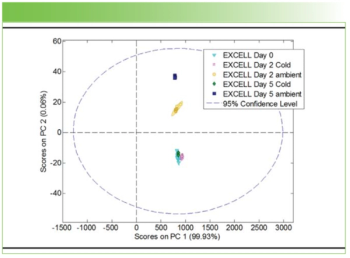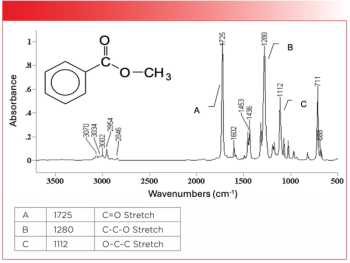
Using Spectroscopy for Greener Recycling for Wind Turbine Waste
Key Takeaways
- Compression milling and fractionation effectively recover high-value materials from wind turbine blades, minimizing environmental impact.
- Wet separation reduces airborne particulate emissions, protecting workers, while compression milling lowers operational costs and extends equipment lifespan.
A recent study highlighted a novel method for recycling aging wind turbine blades, transforming waste into valuable materials while minimizing environmental impact.
The expansion of wind energy has resulted in the increased production of wind turbines. However, this has led to a new environmental challenge that scientists are grappling with, and that’s how to handle aging wind turbines once they reach the end of their operational life. Because of a turbine’s massive composite blades, these components are challenging to recycle (1). And because the amount of wind turbines that have reached the end of their service life has increased dramatically, an enormous volume of composite waste has been produced. A new study, published in the journal Materials, introduces a new method to crush turbine blades and characterize the polymers using spectroscopy (1).
What are wind turbines and how do they work?
Wind turbines are machines designed to convert the kinetic energy of moving air (wind) into electrical energy through a series of mechanical and electromagnetic processes (2). The large blades of a wind turbine are designed like airplane wings, which means that they are curved on one side and flat on the other. This design has a practical purpose: when wind flows over the blades, it creates a pressure difference that causes them to lift and rotate around a central hub (2).
Wind turbines are looked at as an alternative source of energy, one that does not rely on non-renewable resources. It is caused by three main events, including the Earth’s rotation, the differences in terrain, and the sun unevenly heating the atmosphere (2).
What did the researchers do in their study?
The research team documented a new mechanical process for recycling the composite materials from decommissioned wind turbine blades. In their study, the researchers proposed a novel compression milling technique, which they thought could be an environmentally friendly alternative to the traditional knife milling methods currently used in composite waste treatment (1). This approach not only reduced wear on processing tools, but it also minimized the release of harmful particulates, protecting both workers and the environment (1).
Glass and carbon fibers embedded in polymer matrices typically comprise wind turbine blades. This makeup does make turbine components durable but much harder to dispose of. This study looked at how to better recover the valuable materials without negatively impacting the environment (1).
As part of the experimental procedure, the researchers crushed turbine blade waste using the new compression milling process. From this, 15 distinct material samples (WT1–WT15) were identified based on color and texture differences (1). These samples underwent a suite of advanced analytical techniques to uncover their physicochemical and thermal properties.
Then, using Fourier transform infrared spectroscopy (FT-IR), the team confirmed the presence of key polymers such as polyethylene terephthalate (PET), polyethylene (PE), and polypropylene (PP), alongside epoxy and polyester resins, glass fibers, wood, and inorganic fillers (1). This analysis revealed the complexity of the composition of turbine blade waste.
The researchers also employed thermogravimetric analysis (TGA) and differential scanning calorimetry (DSC) to examine the materials’ thermal behaviors. TGA revealed the differences in degradation and thermal stability among the samples, indicating mixtures of organic and inorganic materials (1). Meanwhile, DSC provided detailed insight into phase transitions and thermal properties, which is data crucial for determining potential reuse applications.
To further separate and classify the material fractions, the researchers applied both wet and dry separation techniques. This dual method allowed for a more refined fractionation of components into three primary groups (defined in the study as GF1, GF2, and GF3), each representing materials with distinct compositions and properties (1).
There were a couple key findings worth highlighting about these groups. First, the GF1 fraction (<40 µm) was found to contain a remarkably high residual mass of 89.7%, signaling a predominance of glass fibers, one of the most valuable materials recoverable from turbine blades (1). Second, the GF3 fraction showed greater organic content and lower thermal stability, confirming its composition of resins and other degradable compounds (1).
What are the key takeaways from this study?
There are several key takeaways from this study. First, this study shows that compression milling and fractionation are effective methods in recovering high-value materials while minimizing the environmental impact (1).
Another takeaway is that the wet separation method reduces airborne particulate emissions, protecting workers from inhaling fine particles, while the reduced tool wear of compression milling lowers operational costs and extends equipment lifespan (1).
And finally, the researchers show through their study that future work in this space should focus on optimizing process parameters and evaluating the economic feasibility of industrial-scale applications. In the meantime, their findings show that wind turbine waste can go from being an environmental burden into a valuable resource.
References
- Zhao, X.; Pakula, D.; Frydrych, M.; et al. Treatment and Valorization of Waste Wind Turbines: Component Identification and Analysis. Materials 2025, 18 (2), 468. DOI:
10.3390/ma18020468 - U.S. Department of Energy, How Do Wind Turbines Work? Energy.gov. Available at:
https://www.energy.gov/eere/wind/how-do-wind-turbines-work (accessed 2025-10-29).
Newsletter
Get essential updates on the latest spectroscopy technologies, regulatory standards, and best practices—subscribe today to Spectroscopy.





